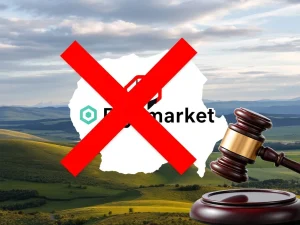Fragile Hope: Can Pi Network Thrive Without Binance Listing?

Pi Network, a cryptocurrency project with a bold ambition to make mining accessible via smartphones, has garnered massive community support. But can it truly succeed and thrive without securing listings on major cryptocurrency exchanges like Binance? Despite millions of users and significant community power advocating for a Binance listing, Pi remains unlisted as of April 2025. Let’s delve into the challenges and possibilities facing Pi Network’s future.
Why is a Binance Listing Crucial for Pi Network’s Success?
The absence of a Binance listing, despite overwhelming community demand, raises critical questions about Pi Network’s trajectory. Think of it like this: imagine launching a groundbreaking product but being denied shelf space in the world’s largest supermarket. That’s essentially the situation Pi Network faces without access to Binance, the leading cryptocurrency exchange by trading volume. Why has Binance remained silent, despite the clear desire of the Pi community for a listing?
Several factors, both official and unofficial, contribute to Binance’s hesitation:
- Blockchain Compatibility Issues: Binance’s listing initiatives often favor projects built on the BNB Smart Chain. Pi Network operates on its own independent blockchain, potentially creating technical hurdles and deviating from Binance’s preferred ecosystem.
- Transparency Concerns: Major exchanges like Binance demand a high degree of transparency regarding token issuance, lock-up mechanisms, and burn strategies. Pi Network’s disclosures may not yet meet these stringent requirements, leading to concerns about the integrity of Pi’s tokenomics.
- Regulatory Uncertainty: Pi Network’s operational model, particularly its referral-based growth, has attracted regulatory scrutiny in some regions, resembling multi-level marketing (MLM). This regulatory ambiguity is a red flag for risk-averse exchanges like Binance.
Did you know? Pi Network’s growth model is inherently viral. New users can only join through an invitation from an existing member, fostering expansion through personal networks.
The Market Struggles of Pi Coin Without Top-Tier Exchange Support
Since missing the coveted Binance listing, Pi Coin’s market performance has reflected the challenges. The price plummeted by approximately 80% from its all-time high, settling around $0.56 in early April 2025. While Pi has found listings on platforms like OKX, Bitget, and MEXC, these exchanges lack the immense user base and credibility that Binance offers. Without Binance’s stamp of approval, gaining mainstream traction in the competitive cryptocurrency market becomes an uphill battle for Pi.
The price chart for Pi Coin has been volatile, characterized by speculative spikes fueled by mainnet rumors or exchange listing teases, followed by inevitable corrections. Sustained upward momentum has proven elusive, and trading volumes remain weak compared to established cryptocurrencies. The Pi Core Team is reportedly working to enhance transparency and address regulatory concerns, positive steps, but whether these efforts will be enough to sway Binance or other top-tier exchanges remains uncertain.
Can Community Power and a Unique Ecosystem Replace a Binance Listing?
The crucial question remains: Can Pi Network carve out a path to success independently, even without listings on major cryptocurrency exchanges? The answer is complex and depends on perspective.
The Optimistic View: Leveraging Community Power and Building an Independent Infrastructure
Pi Network’s greatest asset is undoubtedly its massive community. Boasting tens of millions of users, even amidst growing skepticism, Pi possesses a user base that most crypto projects can only dream of. This scale provides a built-in market for the Pi digital currency, particularly in regions where mobile-first solutions resonate strongly. This inherent community power could be Pi’s secret weapon.
Furthermore, the Pi Core Team is actively promoting real-world utility for Pi. Initiatives like PiFest, where over 125,000 merchants reportedly signed up to accept Pi, demonstrate an effort to establish Pi as a functional currency, not just a speculative asset. While actual payment volumes are still developing, the foundational infrastructure is beginning to take shape.
Pi Network is also focused on building its own self-contained ecosystem, encompassing wallets, decentralized applications, and a proprietary KYC system. By minimizing reliance on external platforms, Pi aims to create a closed-loop economy where users can earn, spend, and exchange Pi within the network. In this vision, major cryptocurrency exchanges might become less critical. Pi could potentially forge its own niche as a digital currency for peer-to-peer transactions and local marketplaces, distinct from the speculative trading arena of open exchanges.
The Realistic View: A Fragile Ecosystem Under Pressure
However, a more pragmatic assessment reveals significant headwinds. Despite initial excitement, Pi Coin’s performance post-mainnet launch has been underwhelming. The token faces substantial inflation pressure. In April alone, over 124 million Pi tokens are being unlocked, with a staggering 1.53 billion slated to enter circulation within the next year, potentially pushing the total supply beyond 8.2 billion. This massive token unlock schedule could further depress the price.
Adding to the woes, the KYC migration process has been plagued with issues. Only a small fraction of users have successfully completed KYC and gained access to their coins, with reports of lost tokens and endless verification loops creating widespread frustration. While smaller exchanges have listed Pi, the absence of tier-one platforms like Binance, Coinbase, and Kraken speaks volumes. The lack of transparent communication from the Pi Core Team regarding development progress and tokenomics further erodes user confidence.
Did you know? Bybit’s CEO reportedly labeled Pi Network a “scam,” a damaging accusation that, while denied by developers, lingers due to the communication gaps.
The Uncertain Future of Pi Network
So, can Pi Network survive and even flourish without major cryptocurrency exchange listings? Technically, survival is possible. However, to truly thrive, Pi needs a fundamental shift towards becoming a functional ecosystem where Pi is actively used, not merely traded speculatively. This necessitates resolving the KYC bottleneck, developing a robust application layer, attracting developers to build on the platform, and demonstrating tangible payment activity.
This is a monumental undertaking. The more probable scenario is that Pi requires at least some level of exchange support to achieve the liquidity, visibility, and trust it currently lacks. Without it, Pi risks remaining a well-intentioned experiment confined to its own ecosystem, or worse, collapsing under the weight of inflated expectations. Pi Network doesn’t necessarily need Binance to exist, but to truly thrive and fulfill its ambitious vision? That remains a very different and challenging story. The fragile hope for Pi Network hinges on its ability to transform community power into real-world utility and overcome the significant hurdles ahead.









